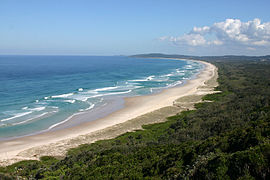
Back نورثرن ریورز FA Côte Nord (Nouvelle-Galles du Sud) French Northern Rivers Italian Northern Rivers Portuguese 北海岸 (新南威尔士州) Chinese
| Northern Rivers New South Wales | |||||||||||||||
|---|---|---|---|---|---|---|---|---|---|---|---|---|---|---|---|
 View south from Byron Bay, the most easterly point on mainland Australia | |||||||||||||||
| Coordinates | 29°09′S 153°07′E / 29.150°S 153.117°E | ||||||||||||||
| Population | 313,422 (2022)[1] | ||||||||||||||
| • Density | 15.11735/km2 (39.15376/sq mi) | ||||||||||||||
| Area | 20,732.6 km2 (8,004.9 sq mi) | ||||||||||||||
| Time zone | AEST (UTC+10) | ||||||||||||||
| • Summer (DST) | AEDT (UTC+11) | ||||||||||||||
| LGA(s) | |||||||||||||||
| State electorate(s) | |||||||||||||||
| Federal division(s) | |||||||||||||||
| |||||||||||||||
Northern Rivers is the most northeasterly region of the Australian state of New South Wales, located between 590 and 820 kilometres (370 and 510 mi) north of the state capital, Sydney, and encompasses the catchments and fertile valleys of the Clarence, Richmond, and Tweed rivers. It extends from Tweed Heads in the north (adjacent to the Queensland border) to the southern extent of the Clarence river catchment which lies between Grafton and Coffs Harbour, and includes the main towns of Tweed Heads, Byron Bay, Ballina, Kyogle, Lismore, Casino and Grafton. At its most northern point, the region is 102 kilometres (63 mi) south-southeast of the Queensland capital, Brisbane.
As with all regions of New South Wales, it has no official status, although state government department offices and local governments in the area work together for purposes such as tourism, education, water catchment management and waste management.[2][3] This area has a mild, sub-tropical climate. Major industries are agriculture, fisheries, public services (particularly health) and tourism; the region is also popular for niche crops, hobby farmers, and retirees from life in the larger cities.
- ^ "Regional Population Growth, Australia, 2021-2022". Australian Bureau of Statistics. April 2023. Retrieved 16 January 2024.
- ^ Northern Rivers Tourism. "Who we are". Retrieved 11 July 2011.
- ^ "Northern Rivers ACE Colleges". Retrieved 11 July 2011.
